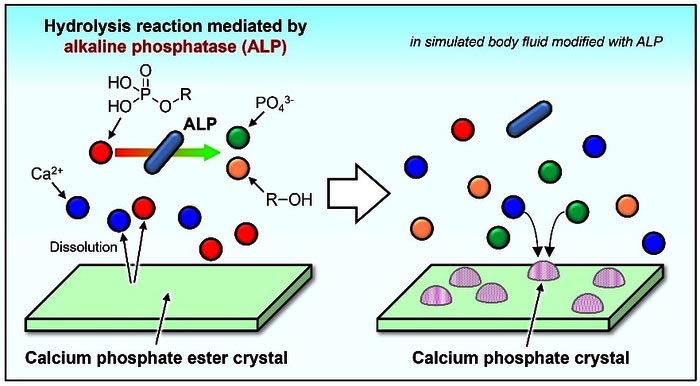Bone, heal thyself

Transformation of a salt of calcium ions and phosphate esters into hydroxyapatite mediated by alkaline phosphatase (ALP)
Credit: Department of Inorganic Biomaterials, TMDU
Toward ceramics tailored for optimized bone self-repair.
Your chance of breaking a bone sometime within the next year is nearly 4%. If you’re unlucky enough to need a bone replacement, it’ll probably be based on a metal part. Unfortunately, metal parts are sometimes toxic over time, and will not help your original bone regrow. Calcium phosphate ceramics—substitutes for the bone mineral hydroxyapatite—are in principle an ideal alternative to conventional metals because bone can eventually replace the ceramic and regrow. However, applications of such ceramics in medical settings have been limited by insufficient control over the rate of absorption and replacement by bone after implantation.
Now, in a study recently published in Science and Technology of Advanced Materials, researchers from TMDU and collaborating partners have studied the effect of the carbon chain length of a phosphate ester ceramic containing calcium ion on the rate of its transformation into hydroxyapatite mediated by alkaline phosphatase which presents in our bones. This work will help move bone regeneration research from laboratories to medical use.
“Medical professionals have long sought a means of healing bone fractures without using implanted medical devices, but the underlying science that can make this dream a reality isn’t yet fully elaborated,” explains lead author Taishi Yokoi. “Our careful analysis of the effect of the ceramic’s ester alkyl chain length on hydroxyapatite formation, in a simulated body fluid, may help develop a novel bone-replacement biomaterial.”
The researchers report two main findings. First, most of the studied ceramics underwent chemical transformations into particulate or fibrous hydroxyapatite within a few days. Second, smaller alkyl groups facilitated faster chemical reactions than larger alkyl groups. Because the rate-limiting step of hydroxyapatite formation is dissolution of the ceramic, the greater solubility imparted by smaller alkyl groups sped up production of hydroxyapatite. Such knowledge gives a means of tailoring the speed of bone regrowth.
“We now have specific chemical knowledge on how to tailor the rate of hydroxyapatite growth from calcium phosphate ceramics,” says Yokoi. “We expect that this knowledge will be useful for bench researchers and medical practitioners to more effectively collaborate on tailoring bone reformation rates under medically relevant conditions.”
The results of this study are important for healing bone fractures after surgery. By using chemical insights to optimize the rate of bone reformation after implantation of calcium phosphate ceramics, patient outcomes will improve, and returns to the hospital years later for further repairs will be minimized.
The article, “Transformation behaviour of salts composed of calcium ions and phosphate esters with different linear alkyl chain structures in a simulated body fluid modified with alkaline phosphatase,” was published in Science and Technology of Advanced Materials at DOI: 10.1080/14686996.2022.2074801
Journal: Science and Technology of Advanced Materials
DOI: 10.1080/14686996.2022.2074801
Article Title: Transformation behaviour of salts composed of calcium ions and phosphate esters with different linear alkyl chain structures in a simulated body fluid modified with alkaline phosphatase
Media Contact
Taishi Yokoi
Tokyo Medical and Dental University
yokoi.taishi.bcr@tmd.ac.jp
Original Source
All latest news from the category: Materials Sciences
Materials management deals with the research, development, manufacturing and processing of raw and industrial materials. Key aspects here are biological and medical issues, which play an increasingly important role in this field.
innovations-report offers in-depth articles related to the development and application of materials and the structure and properties of new materials.
Newest articles

Sea slugs inspire highly stretchable biomedical sensor
USC Viterbi School of Engineering researcher Hangbo Zhao presents findings on highly stretchable and customizable microneedles for application in fields including neuroscience, tissue engineering, and wearable bioelectronics. The revolution in…

Twisting and binding matter waves with photons in a cavity
Precisely measuring the energy states of individual atoms has been a historical challenge for physicists due to atomic recoil. When an atom interacts with a photon, the atom “recoils” in…

Nanotubes, nanoparticles, and antibodies detect tiny amounts of fentanyl
New sensor is six orders of magnitude more sensitive than the next best thing. A research team at Pitt led by Alexander Star, a chemistry professor in the Kenneth P. Dietrich…





















